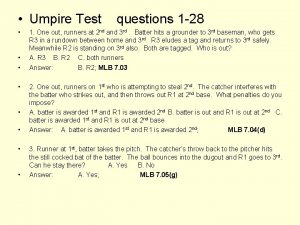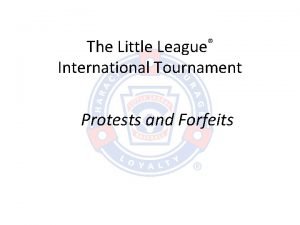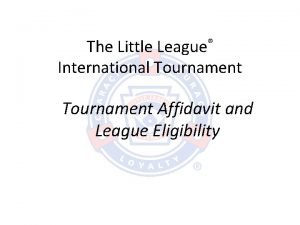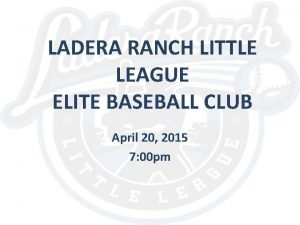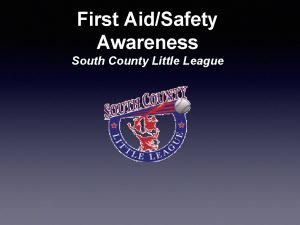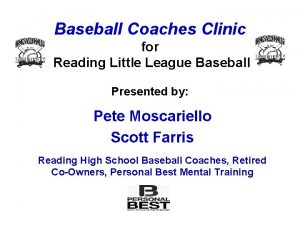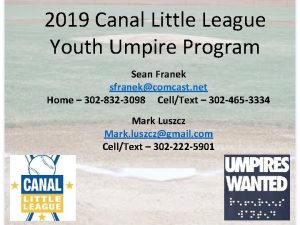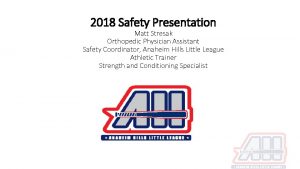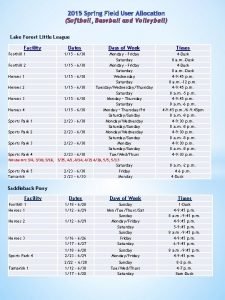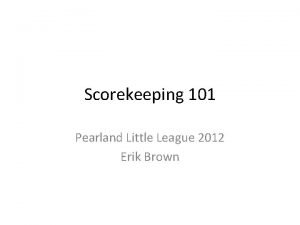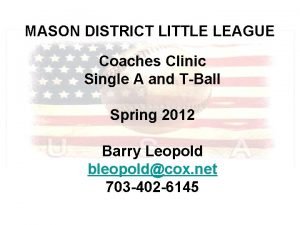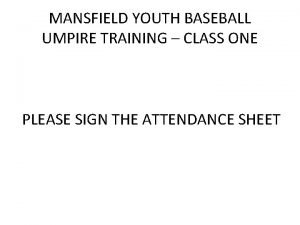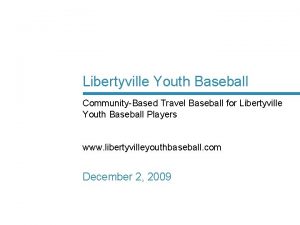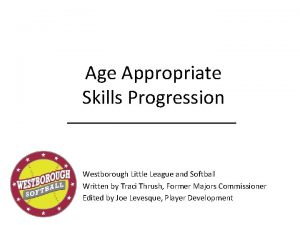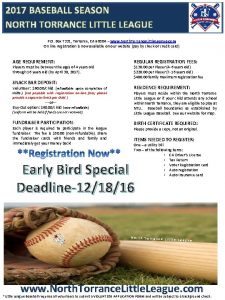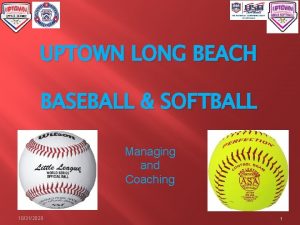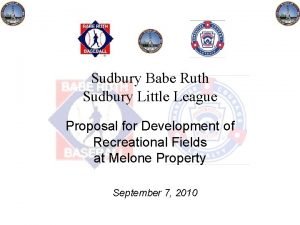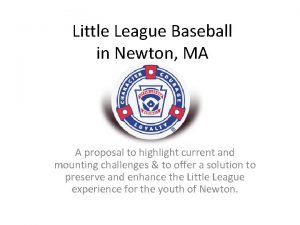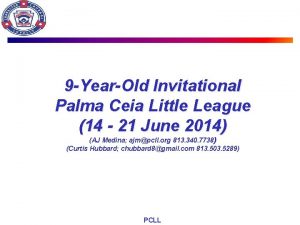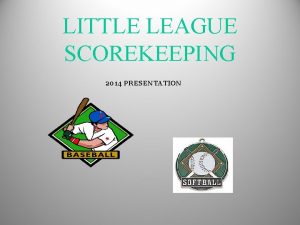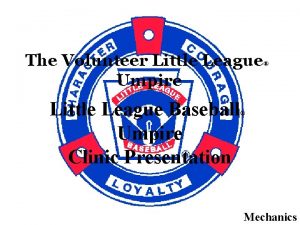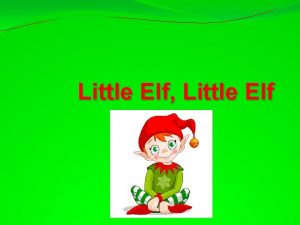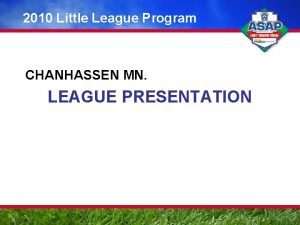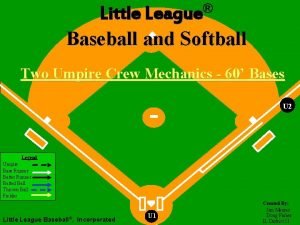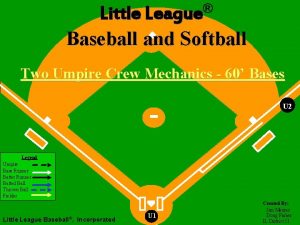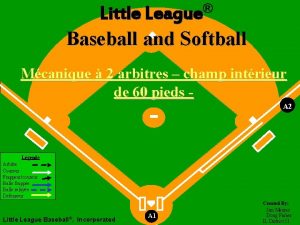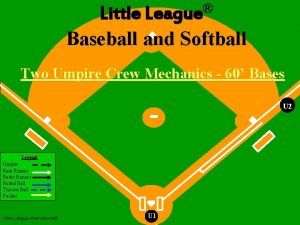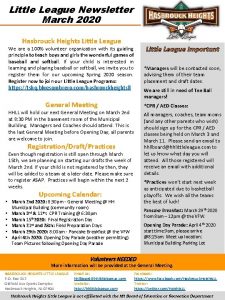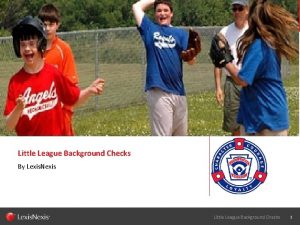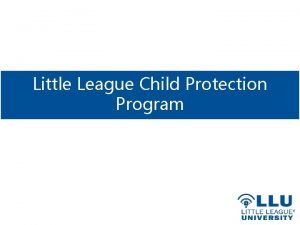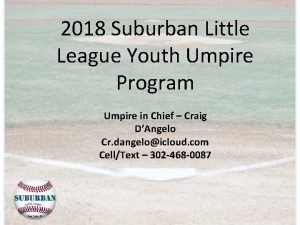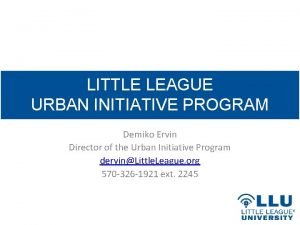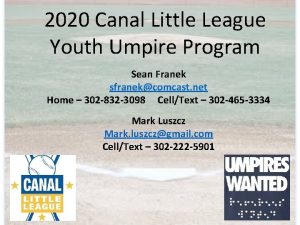The Little League Challenger Program An Adaptive Program
























- Slides: 24

The Little League Challenger Program An Adaptive Program for Children with Physical and Intellectual Challenges

The Little League Challenger Program • Founded in 1989 • Senior League Challenger Division introduced in 2015 • Little League’s adaptive baseball/softball program for boys and girls with intellectual and physical challenges • Today nearly 1, 000 leagues in 10 countries offer the program providing more than 30, 000 children the opportunity to participate

Purpose of the Challenger Program • To provide a community the framework to offer a structured, athletic activity for all youth in their community • To provide all youth the opportunity to enjoy the full benefits of Little League in an environment structured to their abilities

Recent Program Updates • Senior League Challenger Division – Approved by delegates at the 2014 Little League International Congress – For players ages 15 and above – Offered by over 100 leagues in 2015 • Regulation II – Boundaries – Changes approved at the 2014 Little League International Congress – Leagues may sign up players from any area in their district, or an adjacent district, that does not offer the Challenger Program

Who can participate in the Challenger Program? • Any individual with a physical or intellectual challenge that cannot participate in the age appropriate Little League Baseball or Softball Division with reasonable accommodations – Little League Challenger Division: Ages 4 -18* – Senior League Challenger Division: Ages 15 and above *Players age 19 -22 may participate in the Little League Challenger Division if they are still enrolled in a school program and their league does not offer the Senior League Challenger Division

Methods of Offering a Challenger Program • 3 Options – District operated program managed by the DA/ADA for Challenger – ideal option for districts that cover a small geographical area – District wide program operated by a local league – Operated by local leagues using interleague play – ideal option for most districts

Growing the Challenger Program in Your District • Evaluate the current status of the Challenger Program within your District – How many leagues are offering Challenger? • Little League vs. Senior League? – Is there an ADA for Challenger? – What organizations are located in your district that could partner with Challenger Programs? – Are local Challenger Programs a well integrated part of the district and local leagues?

Growing Challenger – Encourage Leagues to Offer the Challenger Division • Encourage leagues to consider adding a Challenger Division during the first District Meeting of the year • Even small communities can offer the Challenger Division - check with local special education departments and service organizations to determine potential interest • Allow leagues looking to start a program to combine with an existing program for the first year to help get their program started

Growing Challenger – Encourage Leagues to Offer the Challenger Program • If no leagues in the district are offering Challenger: – Consider starting a District operated program – Consider allowing a number of leagues to combine to start a program (allowing 2 -3 leagues to combine is ideal) – Appoint an ADA for Challenger and encourage all leagues to appoint a VP of Challenger to work together to start the program in the District

Growing Challenger – ADA for the Challenger Program • If the district does not have any Challenger participation, the ADA for Challenger should work with leagues to start the Challenger Program • If the district does have Challenger, the ADA for Challenger should: – Encourage leagues not offering Challenger to offer the program – Work with local leagues to get sponsorships and establish partnerships for Challenger – Develop a relationship with special education departments in the district to promote Challenger – Coordinate district interleague play and scheduling for Challenger

Growing Challenger – Partnering with Community Organizations • Developing partnerships with community organizations can benefit Challenger Programs both by increasing participation numbers and increasing sponsorships. Some organizations to consider include: – Special Education Departments (Participation) – Service Organizations such as The ARC, Easter Seals, Autism Speaks, Parent Support Groups, etc. (Participation) – Service Organizations such as Kiwanis, the Rotary Club, Lions club, etc. (Sponsorships/Funding)

Growing Challenger – Integrating the Challenger Program into the District • Consider playing a Challenger Exhibition Game during the district tournament to raise awareness for the program • Include the Challenger Program in any district activities • If operating a District chartered program, schedule Challenger games around regularly scheduled local league games to increase exposure

Growing Challenger – Integrating the Challenger Program into a Local League • Include Challenger teams/players in all regularly scheduled activities • Schedule Challenger games between league play games on weekend, if possible to increase exposure for the Division • Play games on the same fields as other league games • Use Little League players as buddies for the Challenger Program, rather than the parents or other family of the player

Challenger Program FAQ’s • Frequently Asked Questions – Are there enough interested players in my community? – Who will run the Challenger Program? – Are special fields needed? – What are the costs involved in adaptive baseball? – What support can Little League provide? – Are grants available to assist leagues? – What rules are adapted for the Challenger Program?

Are there enough interested players in my community? • To determine the number of interested participants, leagues can work with special education departments and other community organizations • Develop relationships with special education departments and have them assist in recruiting – explain Challenger as “adaptive baseball” • Encourage parents of Challenger participants to recruit their players classmates/friends that may have challenges to join the program

Who will run the Challenger Program? • The district should appoint a ADA for Challenger and the local league should appoint/elect a board representative for the Challenger • Local leagues and districts may choose to create a subcommittee to assist in operating Challenger • Challenger ADAs and Challenger board members should provide regular reports to the district and local league boards on Challenger Proram activities

Are special fields required for the Challenger Program? • Challenger games may be played on traditional baseball or softball fields • Synthetic fields may be used • Fields should be easily accessible and near ample parking

What are the costs involved in offering Challenger? • The costs to operate a Challenger Program are similar to those involved with operating any other baseball/softball program and include: – – – Little League Charter Fee: $10 per team Equipment Uniforms Trophies/Awards Field Usage Fees

What support can Little League provide? • Free Training Materials • Full time staff to answer questions • Grants Available – Up to $20, 000 through Little League’s Grow the Game Grant Program • Affordable Insurance Options • Free Rule Books/Guides to operating the Challenger Program

Are grants available for the Challenger Program? • Leagues starting or operating a Challenger Program may apply for grants through Little League’s Grow the Game Grant Program • Maximum Award: $20, 000 • May be used for facility improvements, field adaptations, equipment, etc.

What rules are adapted for the Challenger Program? • Games typically are one or two innings (about 1 hour) – time limits are recommended • Everyone bats every inning and everyone plays defensively • “Buddies” assist players, but only as needed • Games are non-competitive

What rules are adapted for the Challenger Program? (cont’d) • Teams may include up to 15 players – 10 recommended • Players are assigned to a team based on a combination of size, age, and skill level • Players use “buddies” to assist them, as needed, during game play • All teams must use a continuous batting order • A combination of player pitch, coach pitch, and t-ball can be used in a game

League Testimonials • “The Challenger Division is the best thing that our league has done in 50 years. ” • “Every league needs a Challenger Division. The Challenger players taught their “buddies” life lessons that no other could. The Challenger Games reminded us that it is not always about the scoreboard. ” • “Challenger allowed more children to play recreational sports and instilled a new sense of volunteerism in adults and players across our town. Community support has been remarkable; sponsorships have increased along with community involvement in our league. ”

Questions? For additional information, please contact: Sam Ranck Director of the Challenger Division (570) 326 -1921 ext. 2254 sranck@Little. League. org www. Little. League. Challenger. org www. Facebook. com/Little. League. Challenger
 1 little 2 little 3 little indians
1 little 2 little 3 little indians 1 little 2 little 3 little indian
1 little 2 little 3 little indian Little league umpire test answers
Little league umpire test answers Little league protest
Little league protest Little league tournament team eligibility affidavit
Little league tournament team eligibility affidavit Sunset little league rio rancho
Sunset little league rio rancho Hasbrouck heights little league
Hasbrouck heights little league Ladera little league
Ladera little league South county little league
South county little league Reading little league
Reading little league Canal little league
Canal little league Little league shoulder pain location
Little league shoulder pain location Lake forest little league
Lake forest little league Pearland little league baseball
Pearland little league baseball North mason little league
North mason little league My.myba.com
My.myba.com Libertyville little league
Libertyville little league Westborough little league
Westborough little league Torrance little league
Torrance little league Uptown baseball
Uptown baseball Sudbury little league
Sudbury little league Baseball etc newton
Baseball etc newton Palma ceia little league
Palma ceia little league Coaches meeting
Coaches meeting Victor little league
Victor little league


